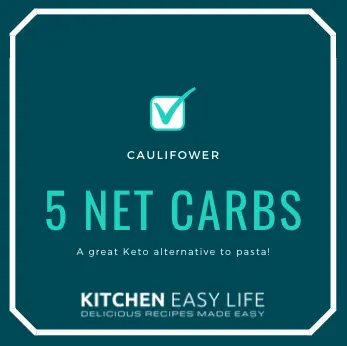Polenta 101: Unveiling the Mystery
Polenta, a staple of Northern Italy, is a traditional dish often made from yellow cornmeal. Its origins are humble, yet it has become a beloved component of Italian cuisine worldwide. However, when it comes to the ketogenic diet, a low-carb, high-fat regime aimed at weight loss and improved metabolic state, one must ask: Is polenta keto?
If you’ve ever tried the keto diet, like I have, you know its benefits are many, but its food choices are few. Well, that is compared to the normal western diet, which is pretty carb-heavy!
The ketogenic diet emphasizes low-carb foods to maintain blood sugar levels and promote a state of ketosis. Anyone who’s been on keto knows you can’t eat corn, which is the main ingredient of traditional polenta. With typically 30 grams of carbohydrates per serving, traditional polenta is incompatible with a low-carb diet. This brings us to the question: Can polenta be keto-friendly?
Polenta may be high in carbs, but keto-friendly alternatives can mimic the textures of a true soft polenta. With the right ingredients and preparation, a polenta-like dish can fit into a ketogenic lifestyle!
The Carb Chronicles: Polenta on the Keto Scale
A cup of polenta can contain up to 30 grams of net carbs, which is enough to knock you out of ketosis.
However, cauliflower rice and almond meal can create a similar taste and consistency with far fewer carbs. For example, cauliflower grits can have as little as 5 g net carbs per serving, making it a keto-friendly alternative. This innovation in keto diet recipes allows for a polenta experience without the carb overload.
Yet, polenta is keto…when modified! With these alternatives, you can enjoy a dish that’s similar to polenta while keeping your carb intake within the limits of a ketogenic diet.
Picking Perfection: Choosing the Right Ingredients

To create a keto-friendly version of polenta, selecting the right ingredients is crucial. The primary ingredient, cornmeal, must be replaced with low-carb alternatives like cauliflower rice or almond meal.
In addition to the base, adding flavors with keto-friendly ingredients like olive oil, parmesan cheese, and cream cheese can elevate the dish to the next level. Parmesan cheese adds a rich flavor, while cream cheese contributes to the creaminess. Olive oil, a staple in Italian cooking, can be used to cook or garnish the dish, adding both flavor and healthy fats suitable for a ketogenic diet.
However, it’s important to keep an eye on the nutrition information of these ingredients. Checking labels for total carbs, grams of fiber, and net carb consumption helps maintain a balanced keto diet. These best tips ensure that your version of polenta is not only delicious but also aligns with your dietary goals.

Mastering the Mix: Recipe Steps for Success
When preparing keto-friendly polenta, the cooking process is just as important as the ingredients. Starting with cauliflower rice or almond meal, cook the base on medium heat to achieve the right consistency. This step is critical in mimicking the textures and flavors of traditional polenta.
As you cook, gradually add in your keto-friendly ingredients like cream cheese, parmesan, and olive oil. The key is to stir continuously and maintain a low heat, ensuring that the mixture doesn’t stick to the pan and achieves a smooth, creamy texture. Remember, patience and attention are your best friends in this cooking process.
Once your keto polenta reaches the desired consistency, it’s time for the final touches. Taste and adjust the seasoning as needed. If you’re feeling adventurous, try adding herbs or spices to match your personal taste and the flavor profile of your meal. This is where you can really make the dish your own and ensure it’s not just a side dish, but a star in its own right.
A Flavorful Fusion: Exploring Ingredient Interactions
The advantage of keto polenta lies in its ability to blend flavors and textures seamlessly. The base, whether it’s cauliflower rice or almond meal, has a neutral flavor that absorbs and complements other ingredients. This creates a perfect balance between the nuttiness of almond meal or the subtle, earthy notes of cauliflower with the richness of added fats like olive oil and cream cheese.
Plus, parmesan cheese adds a savory depth and creamy texture. The combination of these ingredients creates a a flavor that can rival the real thing!
And, keto polenta can easily be paired with a variety of dishes! Try it with our delicious beef and butter!
Its ability to be paired with different flavor profiles means it can be a regular feature in your ketogenic lifestyle, proving that a low-carb diet doesn’t have to be limiting in terms of taste and variety!
Oops! Avoiding Common Kitchen Calamities
When turning traditional polenta into a keto-friendly delight, it’s important to avoid some common kitchen blunders.
First, the right ingredients can make or break your dish! While traditional polenta relies heavily on high-carb yellow cornmeal, opting for keto alternatives like cauliflower rice or almond meal is essential. However, don’t forget to adjust your cooking times and liquid ratios accordingly, as these substitutes behave differently than cornmeal.
In the preparation phase, remember that your keto-friendly polenta might need more binding agents to mimic the texture of the real thing. This is where ingredients like cream cheese or parmesan cheese come in handy. They not only add a creamy texture but also help to bind the mixture. Don’t rush this step; allowing the mixture to cook slowly over low heat ensures the flavors meld beautifully.
During the cooking process, maintaining a consistent temperature is key. Unlike traditional polenta, keto-friendly versions can become too dense or fall apart if cooked at too high or too low heat. It’s also important to stir regularly to prevent sticking and to achieve the creamy consistency of traditional Italian polenta. A little patience here can elevate your dish from good to great!
Variety is the Spice of Keto Life: Recipe Modifications
Changing up flavors can take your polenta keto-friendly dish to the next level!
Experiment with different cheeses like mozzarella or gouda for a richer profile, or add herbs like rosemary or thyme for an aromatic touch.
Olive oil or butter can be used to enhance the richness and bring a smooth, velvety texture, turning your dish into a gourmet experience.
Texture plays a huge role in making polenta keto-friendly satisfying! To mimic the textures of a true soft polenta, consider blending your cauliflower rice or almond meal to a finer consistency. Adding cream cheese or more parmesan can also improve creaminess.
For those craving a bit of crunch, a quick broil in the oven can create a golden brown top layer, adding a delightful contrast to the creamy base.
Carb Culture is Changing
Keto adaptation in culture is fascinating. As the world becomes more health-conscious, many are turning to low-carb diets for weight loss or to manage blood sugar levels.
This shift has allowed us to reimagine traditional dishes like polenta.
By substituting high-carb grains with low-carb alternatives, polenta remains culturally relevant while aligning with new dietary norms.
FAQS
Frequently Asked Questions
Is Polenta Okay on Keto?
Polenta and Keto: Not the Best Match
Polenta, traditionally made from cornmeal, is high in carbs. A keto diet, known for its ultra-low carb approach, typically doesn’t include grains like corn. So, while delicious, polenta isn’t the ideal choice for keto followers.
| Food Item | Serving Size | Net Carbs (grams) | Keto-Friendly? |
|---|---|---|---|
| Polenta | 1 cup | 30 | No |
| Potato | 1 medium | 30 | No |
| Cauliflower | 1 cup | 5 | Yes |
| Zucchini | 1 cup | 3 | Yes |
| Spaghetti Squash | 1 cup | 7 | Moderately |
| Almond Flour | 1/4 cup | 3 | Yes |
How Many Net Carbs are in Polenta?
Polenta’s Carb Content: A Quick Breakdown
A single cup of cooked polenta packs about 30 grams of net carbs. Since keto diets often recommend staying under 20-30 grams of net carbs daily, a single serving of polenta could nearly max out your carb limit!
Is Polenta Lower in Carbs than Potatoes?
Polenta vs. Potatoes: The Carb Comparison
Interestingly, polenta and potatoes are neck-and-neck in carb content. One cup of cooked polenta has roughly the same amount of carbs as a medium-sized potato. So, neither is particularly low-carb friendly.
Is Polenta a Good Carb or a Bad Carb?
Polenta’s Carb Quality: Not All Carbs are Created Equal
Labeling carbs as “good” or “bad” is a bit simplistic. Polenta does provide some nutritional benefits, like fiber and vitamins. However, for those on a keto diet, its high carb content might place it in the “less desirable” category.
Does Polenta Spike Blood Sugar?
Polenta and Blood Sugar: A Cautionary Note
Yes, polenta can cause a blood sugar spike. It has a high glycemic index, meaning it’s rapidly digested and can lead to quicker rises in blood sugar levels. If you’re managing diabetes or on a keto diet, it’s crucial to consider this effect.
Wrap-Up: To Polenta or Not to Polenta?
So, is polenta keto? No, traditional polenta is not keto-friendly. However, with the right modifications, you can create a version that aligns with a ketogenic diet, offering similar taste and texture experiences! While traditional polenta might not fit into a strict keto diet due to its high carb content, there are numerous ways to make polenta keto-friendly.
By substituting high-carb grains with low-carb foods like cauliflower rice or almond meal, and incorporating keto-friendly ingredients like cream cheese and olive oil, you can enjoy a dish that closely resembles the creamy texture and comforting taste of the real thing.
Try our delicious keto-friendly polenta recipe and let us know what you think in the comments!
Cheesy Keto “Polenta” with Almond Meal
Course: DinnerCuisine: AmericanDifficulty: Easy4
servings15
minutes15
minutesThis recipe is sure to delight keto dieters! With low carbs and great taste, it is sure to satisfy!
Ingredients
2 cups cauliflower rice
1 cup almond meal
2 cups chicken or vegetable broth
1/2 cup cream cheese, at room temperature
1 cup grated parmesan cheese
1/4 cup olive oil
1/2 teaspoon garlic powder
Salt and pepper to taste
Optional: Fresh herbs (like thyme or rosemary), for garnish
Directions
- Prep the Cauliflower Rice:
- In a food processor, pulse the cauliflower rice until it reaches a fine, grainy texture, similar to traditional polenta.
- Heat a skillet over medium heat and lightly sauté the processed cauliflower rice for 3-5 minutes to remove excess moisture. Set aside.
- Cook the Almond Meal:
- In a medium saucepan, bring the broth to a gentle boil.
- Slowly stir in the almond meal, whisking continuously to prevent clumping.
- Reduce the heat to low and continue to cook, stirring frequently, until the mixture begins to thicken (about 10-15 minutes).
- Combine Ingredients:
- To the almond meal mixture, add the cooked cauliflower rice, cream cheese, and parmesan cheese.
- Stir well to combine all the ingredients. The cream cheese and parmesan will melt into the mixture, creating a creamy and thick consistency.
- Season:
- Add the olive oil and garlic powder. Season with salt and pepper to taste.
- Continue to cook on low heat for an additional 5-7 minutes, stirring occasionally, until the mixture is creamy and has a thick, bread-like texture.
- Garnish and Serve:
- Transfer the keto “polenta” to a serving dish. If desired, garnish with fresh herbs for an aromatic touch.
- Serve hot as a side dish or as a base for toppings like keto-friendly ragu or sautéed vegetables.

